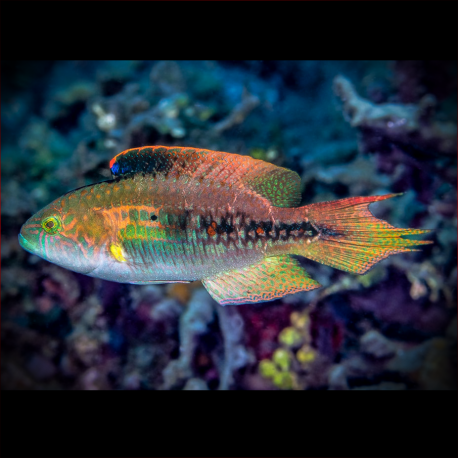More info
Datasheet
| Minimum Tank Size | 500 litres / 132.09 US gallons |
| Maximum Size | 15.0cm / 5.91inches |
| Reef Compatible | Reef safe with caution |
| Temperament | Aggressive towards other species |
| Temperature | 22.2°C / 71.96°F - 25.6°C / 78.08°F |
| Specific Gravity | 1.020-1.025 |
| Carbonate Hardness | 8-12 |
| pH | 8.1-8.4 |
General Description:
The Two-spot wrasse, scientifically known as Oxycheilinus bimaculatus, belongs to the Labridae family. This species is native to the vast Indo-Pacific region, ranging from East Africa to the Hawaiian and Marquesan islands, and from southern Japan to Vanuatu. Wrasses are commonly found in reef aquariums due to their attractive appearance and their usefulness in controlling unwanted invertebrates such as flatworms and pyramid snails. Two-spot wrasses have a maximum size of approximately 15.0cm and are known for their striking coloration and distinctive two spots on their body.
Aquarium Suitability:
The Two-spot wrasse is considered suitable for aquariums with care. They have an average level of hardiness and require a minimum tank size of 500 liters. These fish thrive best when they have ample hiding places, such as between live rocks, in the aquarium. It is recommended to allow them to acclimate without disturbance as they may initially hide while adjusting to their new environment. Two-spot wrasses prefer swimming in open spaces and are known to rearrange rocks and sand within the tank.
Care and Hardiness:
Two-spot wrasses have average hardiness levels and exhibit aggressive behavior towards other species. They require a varied diet consisting of fish, larger crustaceans, other invertebrates, and small crustaceans like krill and mysis. Providing a living feed can increase the chances of success in keeping this species in captivity. These fish also need a tank with stable water conditions, including a pH of 8.1-8.4, a specific gravity of 1.020-1.025, and a temperature range of 22.2-25.6°C.
Reef Suitability:
Two-spot wrasses are considered reef safe with caution. While they can coexist with reef organisms, they may pose a threat to certain invertebrates such as shrimps, crayfish, crabs, small bivalves, sea urchins, and snails. Additionally, they may exhibit aggressive behavior towards smaller fish in a reef environment.
Aquarium Setup:
When setting up an aquarium for Two-spot wrasses, it is essential to provide ample hiding spaces using live rocks and secure the rocks in place to prevent them from toppling over. These fish thrive in environments with plenty of open swimming space and do best when kept as solitary individuals in the tank. Special attention should be given to maintaining stable water parameters to ensure the well-being of the Two-spot wrasse.
Behaviour:
Two-spot wrasses are known for their aggressive temperament towards other species. They may exhibit territorial behavior and should be kept in a tank with appropriate space to prevent conflicts with tankmates. These fish are active swimmers and exhibit interesting behaviors such as rearranging rocks and sand within the aquarium.
Feeding and Diet:
Two-spot wrasses require a varied diet that includes fish, larger crustaceans like shrimp and crabs, other invertebrates, and small crustaceans such as krill and mysis. Providing live food can aid in the successful acclimation of this species to aquarium life. Ensuring a diverse and nutritious diet is crucial for the health and well-being of Two-spot wrasses in captivity.
Habitat and Distribution:
In the wild, Two-spot wrasses can be found in the East Indian Ocean, West Indian Ocean, Australia, Japan, Indonesia, East Pacific, and Central/West Pacific regions. They inhabit a range of marine environments, from rocky reefs to coral reefs, where they feed on zooplankton, large crustaceans, sea urchins, and other small marine organisms. Understanding their natural habitat and distribution is key to providing a suitable environment for Two-spot wrasses in captivity.

